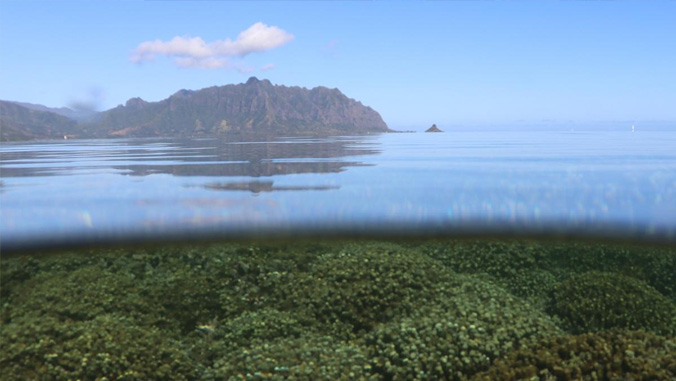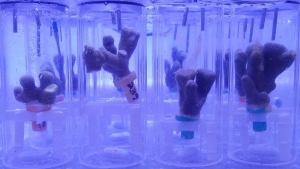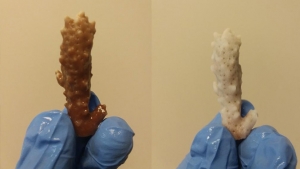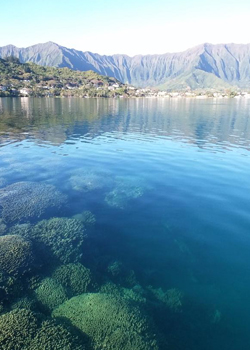
Coral reefs are facing threats that are driving their decline, including the planet’s warming waters. This threat hit record levels in 2015, when high temperatures were turning corals white around the globe. In particular, Kāneʻohe Bay was hit hard with nearly half of its corals bleached.
Hidden in the aftermath of this extreme event were biochemical clues as to why some corals bleached while others were resistant, information that could help reefs better weather warming waters in the future. These clues were uncovered by researchers at the University of Hawaiʻi at Mānoa and Michigan State University (MSU), and published in a report in Nature Ecology & Evolution.
“It was kind of horrifying,” said Crawford Drury, a coral biologist at UH Mānoa’s Hawaiʻi Institute for Marine Biology (HIMB), who witnessed the 2015 bleaching event from Florida. “It’s disheartening to watch, but I try to think of it as an opportunity.”
Coral chemical signatures


The researchers discovered chemical signatures in the corals’ biology or biomarkers, that are present in organisms that were most resistant to the bleaching. This previously hidden insight could help researchers and conservationists better restore and protect reefs around the world.
“Usually, we think of biomarkers as signatures of disease, but this could be a signature of health,” said Robert Quinn, an assistant professor in MSU’s Department of Biochemistry and Molecular Biology. “This could help us restore reefs with the most resistant stock.”
Corals are symbiotic communities, where coral animal cells build homes for algae that provide them energy and create their colors. When corals bleach, however, the algae are lost and leave behind bleached skeletons that are susceptible to disease and death.
This symbiosis also plays a role in a coral’s resistance and resilience to bleaching, which HIMB was in a unique position to investigate because the institute sits right next to the reef enabling experiments in real time.
Tagging individual corals
During the 2015 bleaching event, Gates Coral Lab researchers tagged individual corals to keep tabs on them. Since most of the corals recovered, they could be followed through time.
“We think about it as a biological library,” said Drury, the principal investigator with the Gates Coral Lab. “It was set up by researchers in our lab who knew it would be valuable.”
Following the bleaching, the team compared and contrasted coral samples in the wild, noting how the organisms responded and recovered, making some surprising observations along the way. For example, neighboring corals could behave completely differently in response to high temperatures. One coral could bleach completely while its neighbor maintained a healthy golden hue.
Analyzing biochemicals of corals

To understand why, Drury and HIMB postdoctoral researcher Ty Roach, the lead author of the study, sent samples to Quinn and his team, where they could thoroughly analyze the biochemicals of corals collected from this biological library using a method called metabolomics.
Quinn’s team found that corals that were resistant to bleaching had very different biochemical profiles than those that were susceptible. The distinguishing feature between these corals was found in specific lipids from their algal symbionts and the coral cells. The researchers’ metabolomic analysis detected two different lipid formulations. Bleaching-resistant corals featured algae that have what are known as saturated lipids. Susceptible corals had more unsaturated lipids. “This is not unlike the difference between oil and margarine, the latter having more saturated fat making it solid at room temperature,” said Quinn.
Having this chemical information is promising for coral conservation. When conservationists reseed corals to help restore reefs, they can potentially select more resilient specimens based on their lipid profiles.
“We can use natural resilience to better understand, support and manage coral reefs under climate change,” Drury said.
The initial project was funded by Paul G. Allen Family Foundation as part of its integrated ocean health program and coral reef portfolio that includes scientific research, policy support and innovative funding models.
This research is an example of UH Mānoa’s goal of Excellence in Research: Advancing the Research and Creative Work Enterprise (PDF), one of four goals identified in the 2015–25 Strategic Plan (PDF), updated in December 2020.

